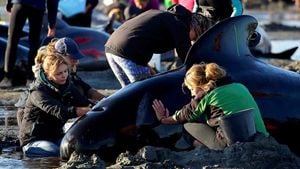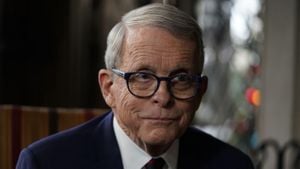NASA astronauts Sunita Williams and Butch Wilmore are facing unexpected challenges as they continue to remain stranded aboard the International Space Station (ISS). Originally scheduled for only eight days, their stay has been significantly extended due to serious technical issues with the Boeing Starliner spacecraft.
The Starliner, which successfully transported the astronauts to the ISS, encountered thruster failures and helium leaks en route. These problems have prompted NASA to postpone their return, leaving families and experts concerned about the astronauts' health and well-being.
Deanna Wilmore, Butch’s wife, shared her thoughts during a recent interview, saying, "You know, we sort of don’t expect him until February or March." The extended stay, she noted, has been challenging but her husband remains content, feeling secure under the circumstances.
Meanwhile, Sunita’s husband, Michael Williams, mentioned she finds peace aboard the ISS, adding, "That's her happy place." This sentiment reflects the astronauts’ adjustment to their unexpected situation, where they continue to conduct experiments and communicate with family from space.
NASA's chief astronaut, Joe Acaba, indicated the astronauts might remain there for up to eight months. He reassured the public during a media teleconference, asserting, "We have done multiple successful, long duration missions, even up to a year,” highlighting their capability to adapt.
While they could potentially hitch a ride home on ELON Musk's SpaceX Crew Dragon, NASA is also considering repairs to the Starliner. Plans for recovery could also be affected by schedules, as the next SpaceX mission has been delayed until September.
Both astronauts are not alone aboard the ISS, as they share the space with the well-established Expedition 71 crew. This collaboration eases the burden of their extended mission, allowing for shared experiences and reduced loneliness.
Families of the astronauts report frequent communication with their loved ones, utilizing modern technology like FaceTime. According to Butch’s daughter, Daryn, “It is so cool. He gives us a lot of Earth views, especially sunsets,” indicating the connection remains strong even from hundreds of miles above.
Despite the challenges posed by extended spaceflight, both astronauts are actively involved with scientific research and maintenance on the ISS. Since arriving, they have adapted to their surroundings and have worked on several projects related to human health and technology utilization.
Looking beyond the immediate technical difficulties, there are concerns over the astronauts' health due to extended exposure to microgravity and radiation. NASA acknowledges the body’s response to long-term space habitation, including muscle loss and vision problems, which will need monitoring upon their return.
Health experts like ISRO Chairman S Somanath have voiced their insights on the physiological challenges. He mentioned the redistribution of fluids experienced can lead to increased intracranial pressure, impacting cognition and causing headaches, illustrating the significant health monitoring needed for astronauts.
Bone density and cardiovascular health can also deteriorate due to the lack of gravity. These issues are notable risks for astronauts like Williams and Wilmore, who need to maintain their fitness levels during their extended stay.
Some experts have suggested astronauts might face psychological challenges during their prolonged mission duration. Extended isolation can lead to anxiety, depression, and even PTSD, adding another layer of complexity to their already demanding environment.
NASA is not only focused on the astronauts' physical health but also emphasizing mental wellness during their mission. According to the agency, they are implementing strategies to support the crew's psychological well-being during this challenging period.
Back on Earth, their families have been vigilantly following the developments, remaining hopeful. Butch’s wife, Deanna, reflected on their predicament, saying, “You just sort of have to roll with it and expect the unexpected,” embodying the resilience of families supporting their astronauts.
The technical issues faced by the Starliner have raised discussions about future missions and risks associated with human space travel. NASA aims to learn from these experiences to improve safety and performance for missions to come.
Looking forward, it remains uncertain when Williams and Wilmore will finally return to their families. Nevertheless, with advances being made and resources being dedicated to their safe return, hope remains high.
Expert opinions suggest the timeline is contingent upon resolving the spacecraft's issues. Currently, NASA and Boeing continue to analyze the spacecraft's malfunctions, determining the best path forward.
Families have expressed their eagerness to welcome home their loved ones. Michael Williams poignantly stated, “She [Suni] thrives doing what she loves,” underscoring the deep connection astronauts maintain with their vocations.
While the astronauts are making the most of their extended presence aboard the ISS, the emphasis remains on their safe return. The whole situation is being closely monitored and awaits resolution, with mixed feelings of nostalgia and anxious anticipation from loved ones left on Earth.
American and international communities eagerly await updates as this complex and evolving story continues to develop. The plight of Williams and Wilmore serves as both inspiration and reminder of the unique challenges faced by space explorers.
Every update will bring hope along with concerns as astronauts adapt to their temporary home among the stars. The extended mission reflects not only on personal journeys but on the remarkable pursuit of human knowledge and exploration beyond our planet.



